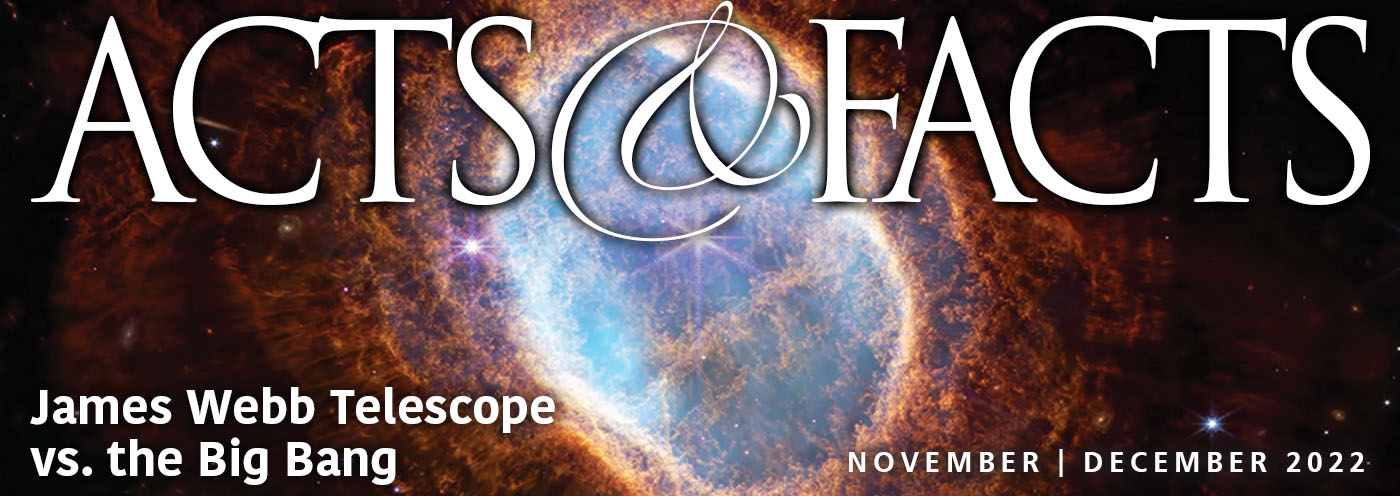The Uniformitarian Century
One of the surprising developments of the past decade has been the resurgence of catastrophism in geological interpretation. Although the great men who were the real founders of geology (Steno, Woodward, et al.) were not only catastrophists but believed in the Noahic Flood as the most important geologic event in earth history, the principle of uniformitarianism has dominated geological thinking for the past 150 years. The Scottish agriculturalist, James Hutton, and then the British lawyer, Charles Lyell, persuaded their contemporaries to reject the Biblical chronology and its cataclysmic deluge in favor of very slow processes acting through aeons of time. In his widely used textbook, Zumberge stated as recently as 1963:
Opposed to this line of thinking was Sir Charles Lyell (1797-1875), a contemporary of Cuvier, who held that earth changes were gradual, taking place at the same uniform slowness that they are today. Lyell is thus credited with the propagation of the premise that more or less has guided geological thought ever since, namely, that the present is the key to the past. In essence, Lyell's doctrine of uniformitarianism stated that past geological processes operated in the same manner and at the same rate they do today.1
Nevertheless, the evidence for catastrophism was there in the rocks and it could not be ignored indefinitely. Uniformitarianism was proving sterile --present processes operating at present rates simply could not explain the great geological formations and structures in the earth's crust, not to mention its vast fossil graveyards. Zumberge noted:
From a purely scientific point of view, it is unwise to accept uniformitarianism as unalterable dogma.… (One) should never close his mind to the possibility that conditions in post geological time were different than today.… 2
A few geologists (Krynine, Bretz, Dachille, et al.) had even earlier begun to call attention to certain strong geologic evidences of more than normal catastrophism in the geologic column. Even Lyell, of course, had recognized the significance of local floods, volcanic eruptions, etc., but had included these in his overall uniformitarian framework. Such phenomena as the "scabland" areas of Washington and the earth's many meteoritic scars, however, had begun to convince some geologists that even "ordinary" catastrophes were not the whole story.
The New Catastrophism
The recent revival of catastrophism seems to have been associated with a number of brilliant papers by Stephen Jay Gould, a geologist and historian of science with impeccable credentials. Gould first stressed the necessity to distinguish between uniformity of natural laws and uniformity of process rates.
Uniformitarianism is a dual concept. Substantive uniformitarianism (a testable theory of geologic change postulating uniformity of rates of material conditions) is false and stifling to hypothesis formation. Methodological uniformitarianism (a procedural principle asserting spatial and temporal invariance of natural laws) belongs to the definition of science and is not unique to geology.3
It is interesting to note that writers on Biblical catastrophism have always stressed that they are only rejecting the concept of uniform rates, not that of uniformity in natural laws. Gould was merely repeating what catastrophists had long emphasized.
More recently, Gould has recognized this fact, while also calling attention to the devious methods by which Lyell and others in the 19th century had persuaded their contemporaries to reject Biblical catastrophism in favor of uniformitarianism:
Charles Lyell was a lawyer by profession, and his book is one of the most brilliant briefs ever published by an advocate ... Lyell relied upon true bits of cunning to establish his uniformitarian views as the only true geology. First, he set up a straw man to demolish ... In fact, the catastrophists were much more empirically minded than Lyell. The geologic record does seem to require catastrophes: rocks are fractured and contorted; whole faunas are wiped out. To circumvent this literal appearance, Lyell imposed his imagination upon the evidence. The geologic record, he argued, is extremely imperfect and we must interpolate into it what we can reasonably infer but cannot see. The catastrophists were the hard-nosed empiricists of their day, not the blinded theological apologists.4
Lest anyone misunderstand, it should be emphasized that Gould is neither a creationist nor a Biblical catastrophist. In fact he and other modern geological quasi-catastrophists are confident that their battle with the Bible has been won and that they can now safely and openly revert to catastrophism in their geological interpretations without the danger of appearing to support Biblical supernaturalism. Gould had said, for example:
As a special term, methodological uniformitarianism was useful only when science was debating the status of the supernatural in its realm; for if God intervenes, then laws are not invariant and induction becomes invalid.… The term today is an anachronism.…5
Similarly, another modern writer criticizing uniformitarianism explains why the principle is nevertheless useful in argumentation.
Frequently the doctrine of uniformitarianism is used fruitfully to explain the anti-catastrophist viewpoint of history.…6
The author of a recent book promoting geological catastrophism feels it necessary to hedge his conclusions with the following caution:
It is both easy and tempting ... to adopt a neocatastrophist attitude to the fossil record.… This is a heady wine and has intoxicated paleontologists since the day when they could blame it all on Noah's flood. In fact, books are still being published by the lunatic fringe with the same explanation. In case this book should be read by some fundamentalist searching for straws to prop up his prejudice, let me state categorically that all my experience (such as it is) has led me to an unqualified acceptance of evolution by natural selection as a sufficient explanation for what I have seen in the fossil record. I find divine creation, or several such creations, a completely unnecessary hypothesis. Nevertheless this is not to deny that there are some very curious features about the fossil record.7
Another recent book8 documents that the modern approach to geomorphology (which stresses erosion by hydraulic processes) was originally established by Woodward and the other catastrophist founders of geology, and was believed by them to be perfectly consistent with the Biblical history of the earth under the divine Curse. This true empirical approach to geology had been retarded by Hutton and other deists with their principle of uniformitarianism, and a steady-state earth. A reviewer of this book makes the following interesting comment:
With the Mosaic chronology finally discredited and denudation again theologically respectable [that is, by Hutton's rationalizations -- author], nineteenth century British geologists could return to the issue of fluvialism.9
Uniformitarian Catastrophism
Creationist writers have been saying for years10 that uniformitarianism was inadequate to explain any of the important types of geologic formations. It is not only that uniformitarianism does not explain everything -- the fact is, it explains nothing! More and more, it has become apparent that the present is not the key (not even a key) to the past, as far as process rates are concerned.
This important fact, categorically denied for so long by evolutionists and uniformitarians, is now being acknowledged more and more openly by both. Typical of this modern trend is the important book by Derek Ager, The Nature of the Stratigraphical Record, mentioned earlier. Although Ager insists he is an evolutionist and uniformitarian, the theme of his book is that every type of geologic formation and structure was formed by some kind of catastrophe. He does not believe they were all formed by the same catastrophe, of course, but by many different catastrophes, separated from each other in a typical uniformitarian framework of billions of years of time -- a sort of "uniformitarian catastrophism," in other words.
Dr. Ager discusses in detail all the various types of geologic formations, even those traditionally believed to have been formed very slowly, concluding that all must have been formed rapidly.
The hurricane, the flood, or the tsunami may do more in an hour or a day than the ordinary processes of nature have achieved in a thousand years.11
This assessment by Ager almost sounds Biblical -- "one day is with a catastrophe as a thousand years!" As a matter of fact, the famous verse in II Peter 3:8, though commonly misinterpreted to teach that the "days" of creation were "thousands of years" long, really means exactly what Ager implied. God is not limited to uniformitarian rates to accomplish his work. He can do in one day what uniformitarian assumptions indicate would require a thousand years. Ager continues:
Given all the millennia we have to play with in the stratigraphical record, we can expect our periodic catastrophes to do all the work we want of them.12
The conclusion of Ager's book, after examining all the evidence, is as follows:
In other words, the history of any one part of the earth, like the life of a soldier, consists of long periods of boredom and short periods of terror.13
That is, everything we can actually see in the geologic strata is the product of catastrophism. The intervening periods, which supposedly totaled billions of years, presumably left no record in the rocks. Individual formations were deposited rapidly; the "unconformities" between formations were periods of either erosion or inactivity.
One or Many?
The question remaining is whether these really do represent a myriad of individual catastrophes or whether they might possibly all be parts of the same catastrophe. If it is true, as Ager and others are contending, that we cannot really see the evidences of the ages between the various catastrophes, then it is legitimate to ask how we know such ages really occurred. There is nothing remaining there to measure!
But I maintain that a far more accurate picture of the stratigraphical record is of one long gap with only very occasional sedimentation.14
How long does it take to form a gap?
The only real reason for imposing a billion-year time frame on the catastrophes is the necessity to provide time for evolution. As a matter of fact, the strata themselves show evidence of being a complex of interconnected and continuous regional catastrophes combining to comprise a global cataclysm.
In the first place, the rocks of all "ages" look the same. That is, there are rocks of all kinds, minerals of all kinds, structures of all kinds, in rocks of all ages.
Secondly, every formation grades, somewhere, up into another formation continuously without a time break. This follows from the fact that there is no worldwide "unconformity." An unconformity is a supposed erosional surface between two adjacent rock formations, representing a time break of unknown duration between deposition periods. It was once believed that such unconformities were, indeed, worldwide:
In the early history of stratigraphy, unconformities were overestimated in that they were believed to represent coeval diastrophism over areas of infinitely wide extent.15
It is now known, however, that all such unconformities are of very limited extent, and furthermore, that they have no particular time significance.
Many unconformity-bounded units are considered to be chrono-stratigraphic units in spite of the fact that unconformity surfaces inevitably cut across isochronous horizons and hence cannot be true chronostratigraphic boundaries.16
From these facts, a simple syllogistic line of reasoning can proceed as follows: (1) since every formation was produced rapidly and catastrophically; and (2) since every such formation somewhere grades into another above it without an interruption in the deposition process; and (3) since the whole (of the geologic column) is the sum of its parts; therefore (4) the entire geologic column was formed continuously and rapidly, in a worldwide interconnected complex of catastrophes.
The Geological Quandary
The above discussion is very abbreviated and inadequate, but it does point up the dilemma confronting modern geologists. Having rejected the Biblical record of creation and the flood as the true key to earth history, geologists for a hundred years relied on uniformitarianism as their rule of interpretation. This system has proved utterly sterile, so that they are now being forced to rely increasingly on neo-catastrophism in their current thinking.
However, if all the geologic formations must be explained by catastrophic phenomena which are inaccessible to observation or measurement, and which are incommensurate with present processes, then historical geology is not science, but speculation.
Of late there has been a serious rejuvenation of catastrophism in geologic thought. This defies logic; there is no science of singularities. If catastrophe is not a uniform process, there is no rational basis for understanding the past. For those who would return us to our Babylonian heritage of "science" by revelation and possibility, we must insist that the only justifiable key to the past is probability and the orderliness of natural process; if uniformity is not the key, there is no key in the rational sense, and we should pack up our boots and go home.17
This lament would, in fact, be realistic if we were limited to naturalistic and speculative catastrophism for our interpretations of earth history, for that would be even worse than uniformitarianism! There would remain no possibility at all of acquiring real knowledge about the origin and early history of the world.
But when all else fails, read the instructions! The rocks do bear witness everywhere to a worldwide hydraulic cataclysm. The causes, nature, duration and effects of that cataclysm are recorded accurately, by infallible divine inspiration, in the Holy Scriptures, and all the actual facts of geology can be correlated perfectly with that record. The founders of the science of geology believed that, and it is time for their latter-day intellectual children to return to the faith of their fathers.
References
1 James H. Zumberge, Elements of Geology (New York, 2nd ed., John Wiley and Sons, 1963), p. 200. Zumberge and the writer were graduate students together at the University of Minnesota, in the period 1946-50, in its Department of Geology. He was more favorably inclined toward Biblical catastrophism than were others in the Geology Department and we had a number of good discussions and seemed to have much in common at that time.
2 Ibid., p. 201.
3 Stephen Jay Gould, "Is Uniformitarianism Necessary?" American Journal of Science, Vol. 263, March 1965, p. 223. This same point had been stressed earlier by the writer (The Twilight of Evolution, Philadelphia, Presbyterian and Reformed Publ. Co., 1963, pp. 59-64). Gould has been on the geology faculty at Columbia University and is currently Professor of Geology at Harvard.
4 Stephen Jay Gould, "Catastrophes and Steady-State Earth," Natural History, February 1975, pp. 16-17.
5 Stephen Jay Gould, "Is Uniformitarianism Necessary?" p. 227.
6 James W. Valentine, "The Present is the Key to the Present," Journal of Geological Education Vol. XIV, April 1966, p, 60.
7 Derek V. Ager, The Nature of the Stratigraphical Record (New York, John Wiley and Sons, 1973), p. 19. Ager is Professor and Head of the Department of Geology and Oceanography at the University College of Swansea, England.
8 Gordon L. Davies, The Earth in Decay—A History of British Geomorphology, 1578-1878 (New York, American Elsevier, 1970), 370 pp.
9 R. H. Dott, Jr., Review of "The Earth in Decay," Journal of Geology, Vol. 79, September 1971, p. 633.
10 See, for example, The Genesis Flood, by John C. Whitcomb and Henry M. Morris (Philadelphia, Presbyterian and Reformed, 1961), pp. 200-203, etc., as well as still earlier writings by George McCready Price, Harold W. Clark, and others.
11 D. V. Ager, op. cit. p. 49.
12 Ibid.
13 Ibid., p. 100.
14 Ibid., p. 34.
15 K. Hong Chang, "Unconformity-Bounded Stratigraphic Units," Bulletin, Geological Society of America, Vol. 86, November 1975, p. 1545.
16 Ibid., p. 1544.
17 B. W. Brown, "Induction, Deduction, and Irrationality in Geologic Reasoning," Geology, Vol. 2, September 1974, p. 456.
*Dr. Morris is Founder and President Emeritus of ICR.
















